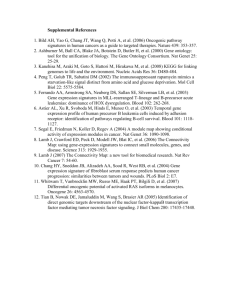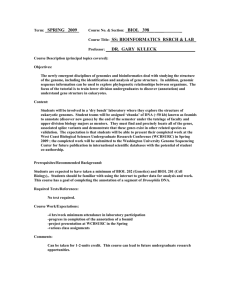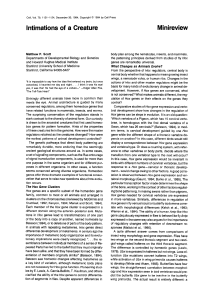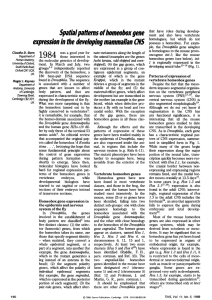TIGS_conclusions - modelspeciesradcliffe
advertisement
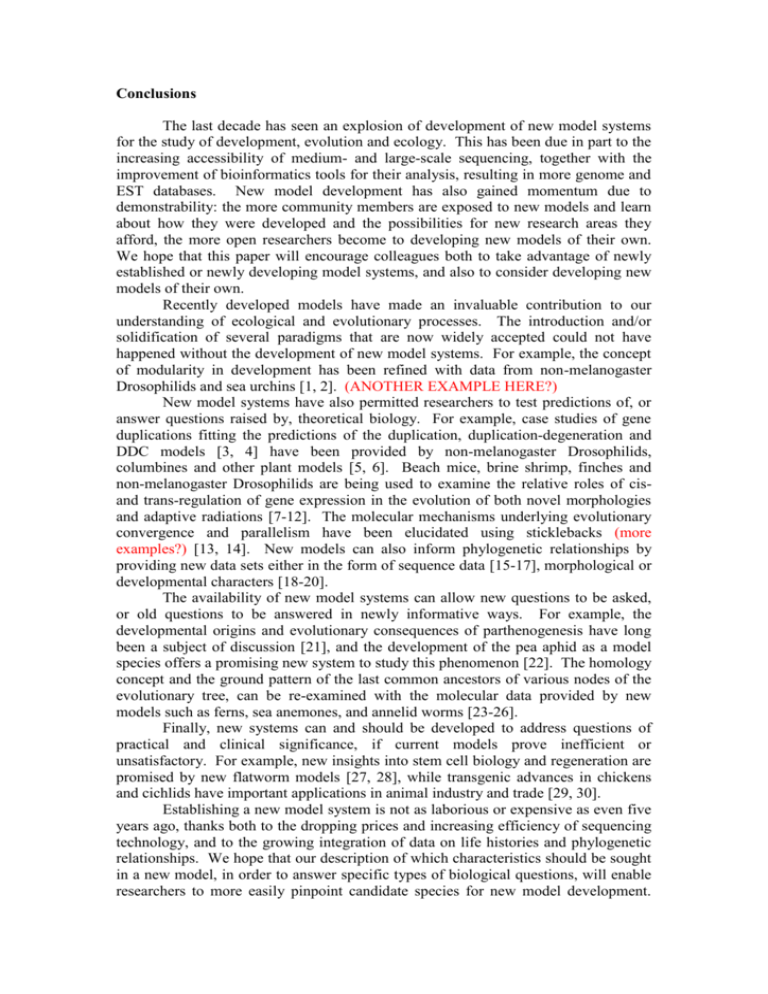
Conclusions The last decade has seen an explosion of development of new model systems for the study of development, evolution and ecology. This has been due in part to the increasing accessibility of medium- and large-scale sequencing, together with the improvement of bioinformatics tools for their analysis, resulting in more genome and EST databases. New model development has also gained momentum due to demonstrability: the more community members are exposed to new models and learn about how they were developed and the possibilities for new research areas they afford, the more open researchers become to developing new models of their own. We hope that this paper will encourage colleagues both to take advantage of newly established or newly developing model systems, and also to consider developing new models of their own. Recently developed models have made an invaluable contribution to our understanding of ecological and evolutionary processes. The introduction and/or solidification of several paradigms that are now widely accepted could not have happened without the development of new model systems. For example, the concept of modularity in development has been refined with data from non-melanogaster Drosophilids and sea urchins [1, 2]. (ANOTHER EXAMPLE HERE?) New model systems have also permitted researchers to test predictions of, or answer questions raised by, theoretical biology. For example, case studies of gene duplications fitting the predictions of the duplication, duplication-degeneration and DDC models [3, 4] have been provided by non-melanogaster Drosophilids, columbines and other plant models [5, 6]. Beach mice, brine shrimp, finches and non-melanogaster Drosophilids are being used to examine the relative roles of cisand trans-regulation of gene expression in the evolution of both novel morphologies and adaptive radiations [7-12]. The molecular mechanisms underlying evolutionary convergence and parallelism have been elucidated using sticklebacks (more examples?) [13, 14]. New models can also inform phylogenetic relationships by providing new data sets either in the form of sequence data [15-17], morphological or developmental characters [18-20]. The availability of new model systems can allow new questions to be asked, or old questions to be answered in newly informative ways. For example, the developmental origins and evolutionary consequences of parthenogenesis have long been a subject of discussion [21], and the development of the pea aphid as a model species offers a promising new system to study this phenomenon [22]. The homology concept and the ground pattern of the last common ancestors of various nodes of the evolutionary tree, can be re-examined with the molecular data provided by new models such as ferns, sea anemones, and annelid worms [23-26]. Finally, new systems can and should be developed to address questions of practical and clinical significance, if current models prove inefficient or unsatisfactory. For example, new insights into stem cell biology and regeneration are promised by new flatworm models [27, 28], while transgenic advances in chickens and cichlids have important applications in animal industry and trade [29, 30]. Establishing a new model system is not as laborious or expensive as even five years ago, thanks both to the dropping prices and increasing efficiency of sequencing technology, and to the growing integration of data on life histories and phylogenetic relationships. We hope that our description of which characteristics should be sought in a new model, in order to answer specific types of biological questions, will enable researchers to more easily pinpoint candidate species for new model development. Even if something cannot be cultured in the laboratory, as long as some samples can be obtained, deep EST and possibly even genome sequencing is possible. However, building a new model can present challenges: a pre-existing research community may or may not exist, and specific tools may have to be targeted for development, possibly requiring significant investments of time and/or money. For example, while RNAi and morpholino advances mean that developing reverse genetics requires only some extent of lab culture, the development of forward or classical genetics requires not just a minimum of genetic map information, but also the space and culture facility to keep dozens or more individual strains alive for the duration of the study, and efficient lab breeding over several generations. Building a collaborative community of researchers interested in a common model can greatly enhance the development of new models. Ultimately, however, increased resources from funding agencies will have to (continue to?) stretch beyond studies on well-established species, to support both the development of new tools (e.g. transgenesis or culture facilities) for fledgling models, and the creation of preliminary tools (e.g. EST collections or BAC libraries) for potential new ones. References 1. 2. 3. 4. 5. 6. 7. 8. 9. 10. 11. 12. 13. 14. 15. 16. 17. 18. Ludwig, M.Z., N.H. Patel, and M. Kreitman, Functional analysis of eve stripe 2 enhancer evolution in Drosophila: rules governing conservation and change. Development, 1998(125): p. 949-958. Arnone, M.I. and E.H. Davidson, The hardwiring of development: organization and function of genomic regulatory systems. Development, 1997. 124(10): p. 1851-64. Ohno, S., Evolution by gene duplication. 1970, New York: Springer Verlag. Lynch, M. and A. Force, The probability of duplicate gene preservation by subfunctionalization. Genetics, 2000. 154(1): p. 459-73. Kramer, E.M., M.A. Jaramillo, and V.S. Di Stilio, Patterns of gene duplication and functional evolution during the diversification of the AGAMOUS subfamily of MADS box genes in angiosperms. Genetics, 2004. 166(2): p. 1011-23. Wang, W., H. Yu, and M. Long, Duplication-degeneration as a mechanism of gene fission and the origin of new genes in Drosophila species. Nat Genet, 2004. 36(5): p. 523-7. Ronshaugen, M., N. McGinnis, and W. McGinnis, Hox protein mutation and macroevolution of the insect body plan. Nature, 2002. 415(6874): p. 914-7. Galant, R. and S.B. Carroll, Evolution of a transcriptional repression domain in an insect Hox protein. Nature, 2002. 415(6874): p. 910-3. Abzhanov, A., et al., Bmp4 and morphological variation of beaks in Darwin's finches. Science, 2004. 305(5689): p. 1462-5. Gompel, N., et al., Chance caught on the wing: cis-regulatory evolution and the origin of pigment patterns in Drosophila. Nature, 2005. 433(7025): p. 4817. Prud'homme, B., et al., Repeated morphological evolution through cisregulatory changes in a pleiotropic gene. Nature, 2006. 440(7087): p. 1050-3. Hoekstra, H.E., et al., A single amino acid mutation contributes to adaptive beach mouse color pattern. Science, 2006. 313(5783): p. 101-4. Colosimo, P.F., et al., Widespread parallel evolution in sticklebacks by repeated fixation of Ectodysplasin alleles. Science, 2005. 307(5717): p. 192833. Shapiro, M.D., M.A. Bell, and D.M. Kingsley, Parallel genetic origins of pelvic reduction in vertebrates. Proc Natl Acad Sci U S A, 2006. 103(37): p. 13753-8. Theodorides, K., et al., Comparison of EST libraries from seven beetle species: towards a framework for phylogenomics of the Coleoptera. Insect Mol Biol, 2002. 11(5): p. 467-75. Philippe, H., N. Lartillot, and H. Brinkmann, Multigene analyses of bilaterian animals corroborate the monophyly of Ecdysozoa, Lophotrochozoa, and Protostomia. Mol Biol Evol, 2005. 22(5): p. 1246-53. Savard, J., et al., Phylogenomic analysis reveals bees and wasps (Hymenoptera) at the base of the radiation of Holometabolous insects. Genome Res, 2006. 16(11): p. 1334-8. Gabriel, W.N., et al., The tardigrade Hypsibius dujardini, a new model for studying the evolution of development. Dev Biol, 2007. 312(2): p. 545-59. 19. 20. 21. 22. 23. 24. 25. 26. 27. 28. 29. 30. Stollewerk, A., M. Weller, and D. Tautz, Neurogenesis in the spider Cupiennius salei. Development, 2001. 128(14): p. 2673-88. Kadner, D. and A. Stollewerk, Neurogenesis in the chilopod Lithobius forficatus suggests more similarities to chelicerates than to insects. Dev Genes Evol, 2004. 214(8): p. 367-79. Halvorson, H.O. and A. Monroy, The Origin and Evolution of Sex. MBL Lectures in Biology. Vol. 7. 1985, New York: Alan R. Liss, Inc. 345. Miura, T., et al., A comparison of parthenogenetic and sexual embryogenesis of the pea aphid Acyrthosiphon pisum (Hemiptera : Aphidoidea). Journal of Experimental Zoology Part B-Molecular and Developmental Evolution, 2003. 295B(1): p. 59-81. Sano, R., et al., KNOX homeobox genes potentially have similar function in both diploid unicellular and multicellular meristems, but not in haploid meristems. Evol Dev, 2005. 7(1): p. 69-78. Finnerty, J.R., et al., Origins of bilateral symmetry: Hox and dpp expression in a sea anemone. Science, 2004. 304(5675): p. 1335-7. Arendt, D., et al., Ciliary photoreceptors with a vertebrate-type opsin in an invertebrate brain. Science, 2004. 306(5697): p. 869-71. Seaver, E.C. and L.M. Kaneshige, Expression of 'segmentation' genes during larval and juvenile development in the polychaetes Capitella sp. I and H. elegans. Dev Biol, 2006. 289(1): p. 179-94. Pfister, D., et al., The exceptional stem cell system of Macrostomum lignano: Screening for gene expression and studying cell proliferation by hydroxyurea treatment and irradiation. Frontiers in Zoology, 2007. 4: p. 9. Sanchez Alvarado, A. and H. Kang, Multicellularity, stem cells, and the neoblasts of the planarian Schmidtea mediterranea. Exp Cell Res, 2005. 306(2): p. 299-308. Maclean, N., et al., Transgenic tilapia and the tilapia genome. Gene, 2002. 295(2): p. 265-77. van de Lavoir, M.C., et al., Germline transmission of genetically modified primordial germ cells. Nature, 2006. 441(7094): p. 766-9.





